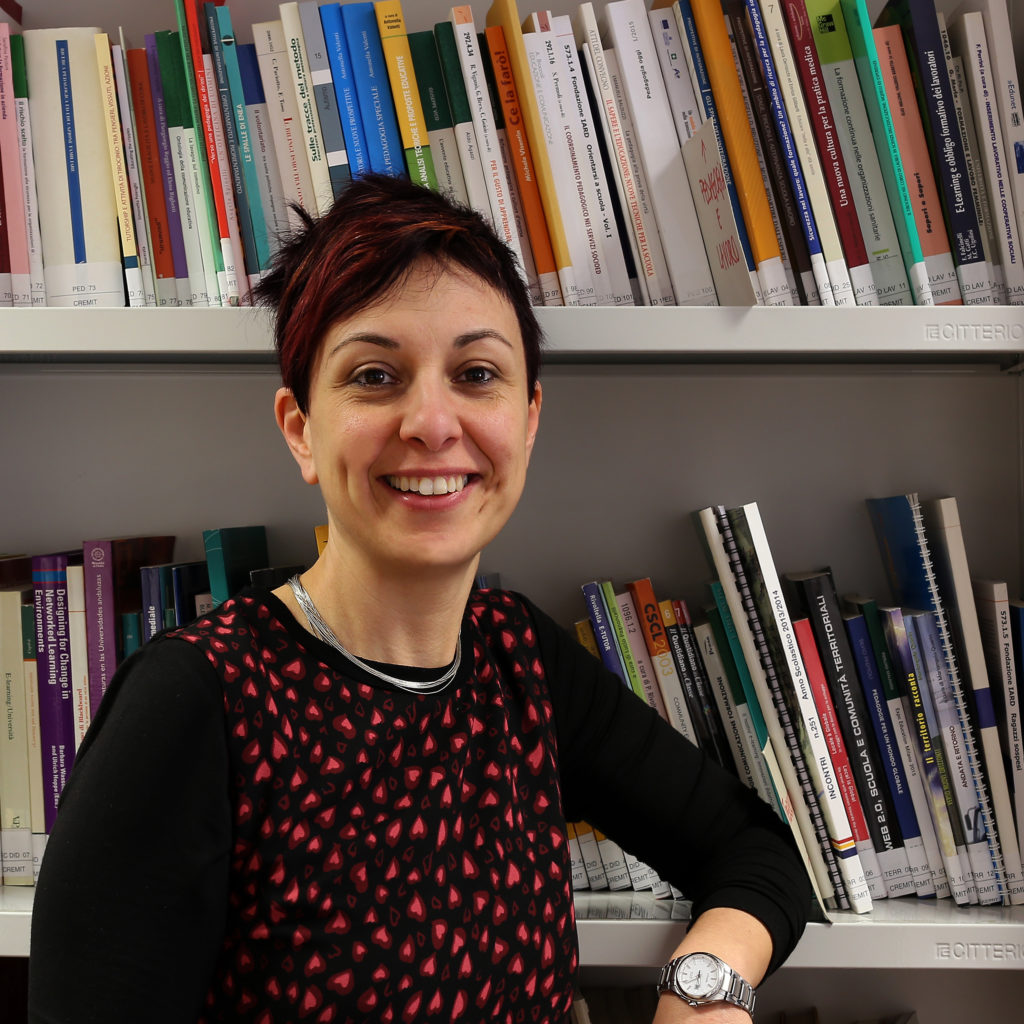
Marco Rondonotti
(Università Cattolica di Milano)
Alessandra Carenzio
(Università Cattolica di Milano)
Irene Mauro
(Università Cattolica di Milano)
Simona Ferrari
(Università Cattolica di Milano)
Elisa Farinacci
(Università di Bologna)
On October 3rd, 2020 as members of the CREMIT research group, we participated in the the annual international World Youth Forum “Right to Dialogue” organized by the Associazione Poesia e Solidarietà (the Poetry and Solidarity Association) in collaboration with the International Study and Documentation Centre for Youth Culture (iSDC) founded in 2013 by the Humanities Department at the University of Trieste, Italy. Within its 13th edition dedicated to “Education: Practices, Challenges, Strategies of Intergenerational Dialogue” we organized the panel “Border Spaces: Digital Technologies as an Opportunity for Hybridization”. Our panel addressed the processes of hybridization that the practices of formal and informal education have been undergoing – and that escalated particularly during the Covid-19 pandemic – discussing it from two different frameworks: “technologies for communities” and “Peer and Media Education” and through the analysis of two different case studies: the Humans of Rizzo project and the TikTok channel opened by CREMIT.
The panel opened with a short video in which Pier Cesare Rivoltella (full professor of Media Education at the Catholic University of Milan and Director of CREMIT) introduces the concept of technologies for communities that he introduced in 2017 with the publication of his book tecnologie di comunità.
The topic is then further discussed by Alessandra Carenzio in her presentation “‘Technologies for Communities’: Technologies to Strengthen and Build Community Ties”. This concept can be defined as a new match between two very well-known words: technologies and community. This framework proposes a new idea: technologies are not just an obstacle, but a support to make the community grow. Technologies can help the creation of new bonds between people or associations, using the medium as a bridge; they can re-activate existing bonds and relationships deteriorated by the worries of everyday life, and build a common ground to meet, share, communicate, and make relationships meaningful again. For example, a big family whose members live in different parts of the world can still share a common life path through the use of technologies. In order to apply this framework at least three actions must be activated. First, it is necessary to study the “geography” of the community (where, how, what is typical of that environment, which associations are working, which groups are active, potential problems, etc.) in order to get a feel for the dynamics taking place in a specific context. Second, the project, which must be activated starting from the people’s needs, needs to be inclusive, open to children, families, schools, old people, immigrants who should be actively involved in the process. Third, platforms and digital solutions ought to be developed and employed to support the project, and meet the participants’ expectations of the community (that is why we usually embrace a co-development approach).

This approach has been adopted within the case study presented by Marco Rondonotti and Irene Mauro in their speech “Humans of Rizzo: A Project for Community Building“. The Humans of Rizzo project took place in a neighborhood of the city of Novara, the “Rizzottaglia” neighborhood. This is an example of application of the community technologies paradigm related to a socio-educational intervention. In particular, it has exploited Digital Storytelling as an educational intervention device in a territorial context which, since the early 1950s, has always been problematic. In this context, Malaw, a young trap singer who resides in the neighborhood, posted the Periferie clip on YouTube, attracting the attention of institutions and the city and regional media. The publication of the clip and the significant number of views immediately produced a great resonance locally; in addition to the message and the slang used to express it, what has most attracted attention is the high number of preteens present in the clip. More than sixty very young people (for a few seconds children also appear) show themselves in a succession of scenes dominated by dark settings, while holding sticks and weapons to expressing an attitude of strong provocation. The choice was to start the “Humans of Rizzo” (HoR) project, which recalls the famous “Humans of New York” page, created in 2010 by Brandon Stanton and which has inspired several similar projects. The aim was to intercept the desire to talk about oneself, creating a social space where young people and adults can express themselves with stories related to the history of the neighborhood. During the research carried out at the same time by CREMIT, which developed the project, Malaw declared that telling his story helped him “to clarify for myself my relationship with the neighborhood and in the meantime, it made me understand some things even better”. This means that the ability to narrate is enhanced through educational processes and is stimulated by the encounter with the narratives of each cultural fabric; in this way, storytelling also acts as an element of connection between the individual and the culture of the context.
The second Framework was presented by Simona Ferrari in her speech “P&M Education: A Methodological Approach”. Peer&Media Education is the integration of Peer Education with Media Education, two methods used in education in which peers, not adults, act in educational projects. When teens themselves play the part of educators, it becomes easier for them to meet as friends and talk about the issues on which the program focuses. The two methods have in common two aspects. (1) The critical thinking. Peer Education trains youngsters so they may help other youngsters to become aware of the risks involved in their behaviour (for example sex and drugs): if teens are able to think critically, they are less exposed to the risks of diseases. Peers help to think critically about the effects of one’s action and behaviour and guide them in making the best possible decision. (2) Digital and social media development. Nowadays the problem with digital and social media does not only involve contents, but also media themselves. Online gambling, online pornography, video gaming, are some of the activities that youngsters could be involved with in our society. In these cases the problem does not concern contents (bad or good, true or false), but the behaviours that the media can promote in youngsters. So Peer Education has to look at Media Education to tackle the problem. The convergence of these methods leads to Peer&Media Education as an educational method that promotes critical thinking, and an ethical and aware use of the media and their messages, and as a strategy for risk prevention.

One of the experimentation that CREMIT conducted on the application of this framework is the use of the popular video making/video sharing app TikTok which I (Elisa Farinacci) presented in my speech “From Lip-syncing to Informal Education on TikTok“. Over the past several months, especially during the Covid-19 pandemic the social media platform TikTok has registered an enormous surge in users and popularity while simultaneously becoming the second most popular social after What’s App. TikTok is a video making and video sharing social network created in 2017, which spread mainly among tweens and teens. With its motto “Make every second Count” The frontiers of video making and video sharing have reached new speeds: if our attention span was already reduced to 2-3 minutes per clip, now the “seconds that count” on TikTok are 15. TikTok is like “a never-ending variety show” and an experience of “pure entertainment”. It’s homepage features a flow of clips accessible by a vertical swipe of never-ending entertainment. Differently from Instagram and Facebook, that are more centered on the curation of a personal profile and the creation of groups of friends, TikTok fits within the binge watching experience that we have become so accustomed to through Netflix. With a group of media educators, kindergarten teachers and researchers from CREMIT we activated an experimentation to explore whether we could use TikTok as a space to activate experiences of informal education. We asked ourselves, How can TikTok be used in an educational context, and with which age groups can we target? How can we position ourselves on this social network? In April we opened our channel @cremit aiming to target college students majoring in Media Education, kindergarten teachers, media educators and teachers. to produce videos Monday through Friday where each day is dedicated to a specific theme/format. Our experiment of thinking about TikTok, as a third space (Potter and McDougall 2017) meant understanding the logics behind this social media, the language it uses, and thus it required bending/adapting our pedagogical tools, methods, and content to TikTok’s rules and dynamics, it means a constant work of translation and adaptation of our knowledge, teaching techniques and objectives so a challenging experience but stimulating and very useful to rethink our teaching strategies and methods.
References
Ferrari, S., Carenzio A., De Cani, L.; Lo Jacono, S. and Rivoltella P.C. (2015). “Sexting, body, identity and images of the self on social media sites among adolescents. From research to action through Peer&Media Education.” In Seminar.net International Journal of Media, Technology & Lifelong Learning. 11(2). https://journals.oslomet.no/index.php/seminar/article/view/2355
Ferrari, S., Veronelli, A., Nardi, E. and Rivoltella P.C. (2016). “Social & Theatre. Body and Identity Education in sexting Prevention.” In Comunicazioni Sociali, 261-271. Milano: Vita e Pensiero.
Floridi, L. (ed.) (2015). The onlife manifesto: Being Human in a Hyperconnected Era. London: Springer.
Jenkins, H. (2013). Spreadable Media: Creating Value and Meaning in a Networked Culture, New York: New York Univesity Press.
McLuhan, M. (1964). Understanding the media: the extensions of man. New York: McGraw-Hill.
Meyrowitz, J. (1985). No sense of place. Oxford: Oxford University Press.
One, W. (1982). Orality and literacy. The technologizing of the word. London: Methuen.
Ottolini, G. and Rivoltella, P.C. (Eds.) (2014). Il tunnel e il kajak. Teoria e metodo della Peer&Media Education. Milano: Franco Angeli
Potter, J. and McDougall, J. (2017). Digital Media, Culture & Education: Theorizing Third Space Literacies. London:Palgrave Macmillan
Rivoltella, P.C. (2020). Nuovi Alfabeti. Educazione e culture nella società post-mediale. Brescia: Scholè.
Rivoltella, P.C. (2017). Tecnologie di comunità, Brescia: Morcelliana.








